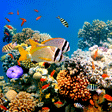- Home >
- Our Actions >
- Ambassador report
5
Comments
Endangered Species in the UAE |
|---|
|
by Asmita Pramanik | 31-05-2018 04:35
|
|
UAE is home to some of the most fascinating species in the world, but their existence seems to be standing at an unsupported, collapsing bridge of livelihood. The continuous over-exploitation of resources and destruction of their natural habitats has made their existence uncertain.
Here are some of the prominent vulnerable species in the UAE who are struggling to keep themselves alive- 1) Spiny-tailed lizard Status: Vulnerable This animal is native to the UAE and other regions of the Middle East such as Egypt, Jordan and Saudi Arabia. Locally known as the ?dhub?, it is well on its way to becoming endangered. CAUSES- In Egypt, large portions of the lizards? habitat have been lost to quarrying for gravel and building material, especially in desert areas. The lizards are also used for food and medicinal purposes.  2)Arabian Tahr Status: Endangered According to the IUCN Red List, there are probably fewer than 5,000 Arabian tahrs left in the world. These animals live in the mountains of northern Oman and the UAE, where they prefer north facing slopes between 1,000 and 1,800 metres high. CAUSES- Intense grazing competition from livestock, illegal hunting and habitat degradation through human development have caused the species to decline severely. Arabian tahr populations in the UAE appear to be localised and possibly isolated which raises the concern that isolation would lead to diminished genetic variation due to inbreeding, which in turn would result in increased susceptibility to disease and decreased fertility, spelling disaster for the Arabian tahr in the UAE.  3)Hawksbill turtle Status: Critically endangered These migratory creatures are found in over 60 countries, and the UAE?s beaches – especially on Saadiyat Island in Abu Dhabi – are regular nesting grounds for them. World Wide Fund for Animals (WWF) has found that there are only approximately 8,000 adult nesting females left in the world. CAUSES- Hawksbill turtles are targeted for their brown and yellow carapace plates that are manufactured into tortoiseshell items, such as jewellery and ornaments. Numerous other reasons for their decline include loss of nesting and feeding habitats due to rising water levels, excessive egg collection, fishery-related mortality, pollution, coastal development and illegal wildlife trade.  ROLE OF UAE IN PROTECTING ENDANGERED SHARKS There are about 550 species of sharks around the world with more than 30 species in the Arabian Gulf. Shark species are threatened or endangered because sharks reproduce in small numbers and their period of growth is very long. CAUSES- Illegal fishing practices, global spread of unethical and uncontrolled fishing methods and the rise of the shark fin trade have emerged as the leading causes for the death of sharks.  UAE is the first country in the Middle East to ratify the Convention on International Trade in Endangered Species of Wild Fauna and Flora (CITES) and it has also enhanced its monitoring and control measures by working with relevant authorities domestically and internationally. These measures include the inspection and audit of fish markets and landing sites with customs and municipalities. Where laws and regulations have been broken concerning shark and fin trading, confiscations and legal action are taken as necessary. The governments regulates shark fishing and trading, stipulates traditional J-hooks must be used to minimize harm to fish that can be returned to the water. The government also states that all protected shark species caught must be immediately returned to the water. UAE has always been at the forefront when dealing with protection of its prized inhabitants and their habitats which establishes it as a country that the world can learn from. USEFUL LINKS- - https://www.thenational.ae/uae/uae-taking-steps-to-protect-endangered-sharks-ministry-says-1.149332 - http://www.adwonline.ae/find-fight-save-uaes-endangered-species/ |
|
|










 Previous : ENDANGERED WHALE SHARKS
Previous : ENDANGERED WHALE SHARKS









5 Comments
Hello Asmita
I hope you are doing well
Great Report
Thank you so much for this report!
Keep writing!
Green cheers
Yours
Hema
Posted 19-03-2020 12:20
Hello Asmita
It is very good of UAE taking the leading role as in protecting endangered species!
When it comes to species which only have few offspring in a generation with long life spans, these threats they are exposed to affects their species' survival a lot more than we imagine. I hope things could get better!
Thanks for the report
Posted 01-06-2018 20:52
Hello Asmita, Hawksbill Turtles have been mentioned for many times a lot in couple of reports written by different E-gen ambassadors.
It was a bit interesting to know of Arabian Tahr, since I thought Tahr species belong to Himalayan territories, but I figured out to know that Arabian Tahr got classified as different species from Himalayan ones.
Thanks for sharing details of endangered species of UAE, and it was really useful info for other E-gen members to get to know about them, too
Posted 31-05-2018 19:20
Thanks for the information.
Posted 31-05-2018 09:22
Hi! Aamita!
It is wonderful to come to know that CITES organisation for fauna and flora have really dedicated themselves and put themselves on the front line to help protect and monitor the species population withing the UAE region.
What I also admire is that fact that, they work not just with authorative power within the region, but are aided internationally as well. I do believe that the rate at which our species are clearing put is alarming, but with organisations such as this, better conservation will be put in place for the future.
Thank you! And Lovely report!
Posted 31-05-2018 06:31